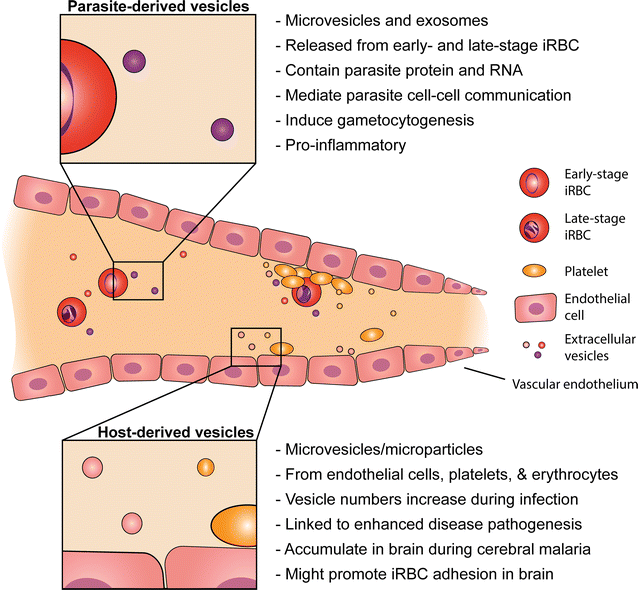The role of extracellular vesicles in malaria biology and pathogenesis
- PMID: 28599650
- PMCID: PMC5466786
- DOI: 10.1186/s12936-017-1891-z
The role of extracellular vesicles in malaria biology and pathogenesis
Abstract
In the past decade, research on the functions of extracellular vesicles in malaria has expanded dramatically. Investigations into the various vesicle types, from both host and parasite origin, has revealed important roles for extracellular vesicles in disease pathogenesis and susceptibility, as well as cell-cell communication and immune responses. Here, work relating to extracellular vesicles in malaria is reviewed, and the areas that remain unknown and require further investigations are highlighted.
Keywords: Exosomes; Extracellular vesicles; Malaria; Microparticles; Microvesicle; Pathogenesis; Plasmodium.
Figures

Similar articles
-
Interplay of extracellular vesicles and other players in cerebral malaria pathogenesis.Biochim Biophys Acta Gen Subj. 2019 Feb;1863(2):325-331. doi: 10.1016/j.bbagen.2018.10.012. Epub 2018 Oct 17. Biochim Biophys Acta Gen Subj. 2019. PMID: 30339917 Review.
-
Production and Characterization of Extracellular Vesicles in Malaria.Methods Mol Biol. 2017;1660:377-388. doi: 10.1007/978-1-4939-7253-1_31. Methods Mol Biol. 2017. PMID: 28828673
-
Role of Extracellular Vesicles in Cellular Cross Talk in Malaria.Front Immunol. 2020 Jan 31;11:22. doi: 10.3389/fimmu.2020.00022. eCollection 2020. Front Immunol. 2020. PMID: 32082312 Free PMC article. Review.
-
[Extracellular vesicles and their role in hematological malignancies].Orv Hetil. 2016 Aug;157(35):1379-84. doi: 10.1556/650.2016.30532. Orv Hetil. 2016. PMID: 27569460 Review. Hungarian.
-
Extracellular Vesicles in Chronic Obstructive Pulmonary Disease.Int J Mol Sci. 2016 Oct 27;17(11):1801. doi: 10.3390/ijms17111801. Int J Mol Sci. 2016. PMID: 27801806 Free PMC article. Review.
Cited by
-
The Benefits of Exporting: Engineered Extracellular Vesicles as Promising Vaccine Candidates against Enteric Fever.Infect Immun. 2021 Mar 17;89(4):e00001-21. doi: 10.1128/IAI.00001-21. Print 2021 Mar 17. Infect Immun. 2021. PMID: 33468582 Free PMC article.
-
Tick Saliva and Salivary Glands: What Do We Know So Far on Their Role in Arthropod Blood Feeding and Pathogen Transmission.Front Cell Infect Microbiol. 2022 Jan 19;11:816547. doi: 10.3389/fcimb.2021.816547. eCollection 2021. Front Cell Infect Microbiol. 2022. PMID: 35127563 Free PMC article. Review.
-
MiRNA: Biological Regulator in Host-Parasite Interaction during Malaria Infection.Int J Environ Res Public Health. 2022 Feb 19;19(4):2395. doi: 10.3390/ijerph19042395. Int J Environ Res Public Health. 2022. PMID: 35206583 Free PMC article. Review.
-
Insights on Host-Parasite Immunomodulation Mediated by Extracellular Vesicles of Cutaneous Leishmania shawi and Leishmania guyanensis.Cells. 2023 Apr 7;12(8):1101. doi: 10.3390/cells12081101. Cells. 2023. PMID: 37190011 Free PMC article.
-
The private life of malaria parasites: Strategies for sexual reproduction.Mol Biochem Parasitol. 2021 Jul;244:111375. doi: 10.1016/j.molbiopara.2021.111375. Epub 2021 May 20. Mol Biochem Parasitol. 2021. PMID: 34023299 Free PMC article. Review.
References
Publication types
MeSH terms
LinkOut - more resources
Full Text Sources
Other Literature Sources
Medical
Miscellaneous

